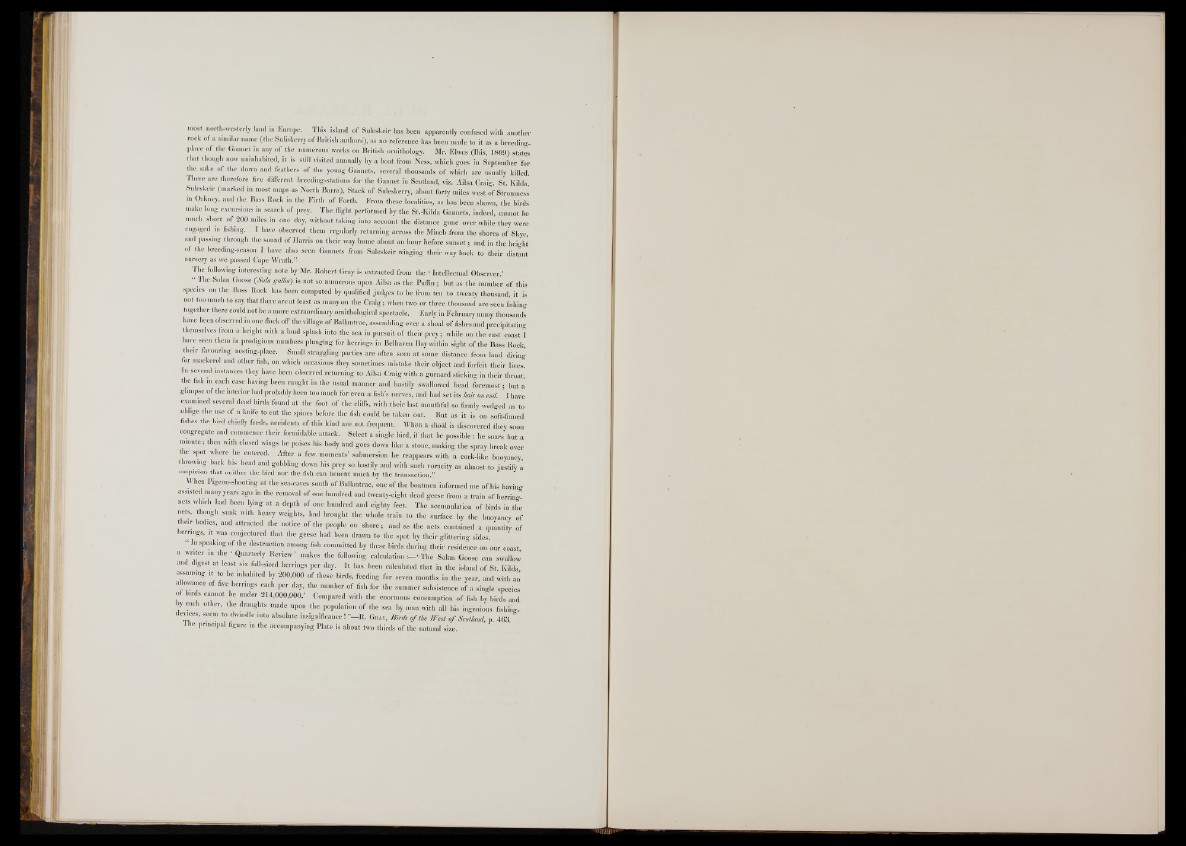
most north-westerly land in Europe. This island of Suleskeir has been apparently confused with another
rock o f a similar name (the Saliskerry o f British authors), as no reference has been made to it as a breeding-
place o f the Gannet in any of the numerous works on British ornithology. Mr. Elwes (Ibis, 1869) states
that though now uninhabited, it is still visited annually by a boat from Ness, which goes in September for
the sake of the down and feathers of the yoong Gannets, several thousands of which are usually killed.
There are therefore five different breeding-stations for the Gannet in Scotland, viz. Ailsa Craig, St. Kilda
Suleskeir (marked in most maps as North Barra), Stack o f Snleskerry, about forty miles west o f Stromness
in Orkney, and the Bass Bock in the Firth o f Forth. From these localities, as has been shown^the birds
make long excursions m search of prey. The flight performed by the St.-Kilda Gannets, indeed, cannot be
much short o f 2 0 0 miles in one day, without taking into account the distance gone over while they were
engaged in fishing. I have observed them regularly returning across the Minch from the shores o f Skye,
and passing through the sound of Harris on their way home about an hour before sunset; and in the height
of the breeding-season I have also seen Gannets from Suleskeir winging, their way back to their distant
nursery as we passed Cape Wrath.”
The following interesting note by Mr. Bobert Gray is extracted from the ‘ Intellectual Observer.;
“ The Solan Goose (Sula galba) is not so numerous upon Ailsa as the Puffin ; but as the number o f this
species on the Bass Bock has been computed by qualified judges to be from ten to twenty thousand, it is
not too much to say that thereare at least as many on the Craig; when two or three thousand are seen fishing
together there could not be a more extraordinary ornithological spectacle. Early in February many thousands
have been observed in one flock off the village o f Ballautrae, assembling over a shoal of fishes and. precipitating
themselves from a height with a loud splash into the sea in pursuit o f their prey ¡. while on the east coast I
have seen them in prodigious numbers plunging for herrings in Belhaven Bay within sight o f the Bass Bock,
their favouring nestmg-place. Small straggling parties are often seen at some distance from land diving
for mackerel and other fish, on which occasions they sometimes mistake their object and forfeit their lives.
In several instances they have been observed returning to Ailsa Craig with a gurnard sticking in their throat;
the fish in each base having been canght in the usual manner and hastily swallowed head foremost;, but a
glimpse o f the interior had probably been too much for even a fish’s nerves, and had set its M r on end. I have
examined several dead birds found at the foot o f the cliffs, with their last monthful so firmly wedged ¡a# tp
oblige the use o f a knife to cut the spines before the fish could be taken but. But as it is on soft-finued
fishes the bird chiefly feeds, accidents o f this kind are not frequent. When a shoal is discovered they soon
congregate and commence their formidable attack. Select a single bird, if that be possible: he soars but a
minute; then with closed wings he poises his body and goes down like a stone, making the spray break over
the spot where he entered. After a few moments’ submersion he reappears with a cork-like buoyancy,
throwing back bis head and gobbling down his prey so hastily and with such voracity as almost to justify a
suspicion that neither the bird nor the fish can benefit much by the transaction|fcfc
When Pigeon-shootmg at the sea-caves south of Ballantrae, one o f the boatmen informed me o f his having
assisted many years ago in the removal o f one hundred and twenty-eight dead geese from a train o f herring-
liets which had been lying at a depth o f one hundred and eighty feet. The accumulation o f birds in the
nets, though sunk with heavy weights, had brought the whole train to the surface by the buoyancy of
tlicir bodies, and attracted the notice o f the people on shore; and as the nets contained a quantity of
herrings, it was conjectured that the geese had been drawn to the spot by their glittering sides.
“ In speaking o f the destruction among fish committed by these birds during their residence on our coast,
a writer in the ' Quarterly Review' makes the following calculation ‘ The Solan Goose can swallow
and digest at least six full-sized herrings per day. It has been calculated that in the island o f St Kilda
assuming it to he inhabited by 2 0 0 ,0 0 0 o f these birds, feeding for seven months in the year, and with an
allowance o f five herrings each per day, the number o f fish for the summer subsistence of a single species
Of birds cannot be under 214,000,000.’ Compared with the enormous consumption o f fish by birds and
y each other, the draughts made upon the population of the sea by man with all his ingenious fishing-
evices, seem to dwindle into absolute insignificance 1 R. Giuv, Birds o f the West o f Scotland, p. 463.
Pnncllla> figure in the accompanying Plate is about two thirds of the natural size.